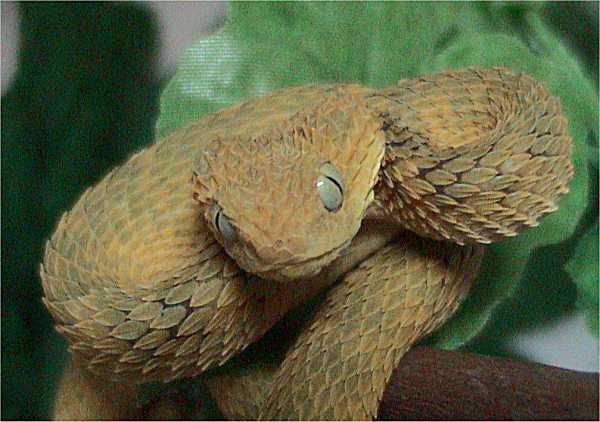|
| Query: Green bush viper | Result: 1st of 9 | |
Green Bush Viper (Atheris squamigera) - Wiki
| Subject: | Green Bush Viper (Atheris squamigera) - Wiki
| |

| Resolution: 600x422
File Size: 66525 Bytes
Upload Date: 2007:09:27 14:46:14
|
Atheris squamigera
From Wikipedia, the free encyclopedia
Common names: green bush viper, variable bush viper, leaf viper, more.
[Photo] Green Bush Viper, Atheris squamigera. Author LA Dawson (http://commons.wikimedia.org/wiki/User:Dawson)
Atheris squamigera is a venomous viper species found in west and central Africa. No subspecies are currently recognized.
Description
Grows to an average length of 46-60 cm, with a maximum of at least 78 cm. Females are usually larger than males.
The head is broad and flat, distinct from the neck. The mouth has a very large gape. The head is thickly covered with keeled, imbricate scales. The rostral scale is not visible from above. A very small scale just above the rostral is flanked by very large scales on either side. The nostrils are lateral. The eye and the nasal are separated by 2 scales. Across the top of the head, there are 7-9 interorbital scales. There are 10-18 circumorbital scales. There are 2 (rarely 1 or more than 2) rows of scales that separate the eyes from the labials. There are 9-12 supralabials and 9-12 sublabials. Of the latter, the anterior 2 or 3 touch the chin shields. The gular scales are keeled.
Midbody there are 15-23 rows of dorsal scales, 11-17 posteriorly. There are 152-175 ventral scales and 45-67 undivided subcaudals. It is possible that there is a variation in morphometric characters related to habitat:
Southern forests Northern grasslands
Midbody dorsal scale rows 17 21
Ventral scales 171 168
Subcaudal scales 52 58
The coloration is the same in some populations, but variable in others. The dorsal color varies from sage green or light green to green, dark green, bluish, olive or dark olive brown. Rare specimens may be found that are yellow, reddish or slate gray. The scales have light-colored keels and sometimes yellow tips that form a series of 30 or more light crossbands or chevrons. On the tail, there are 10-19 chevrons: not always clearly defined, but usually present. The ventral edge of the dorsum has light spots in pairs. An interstitial black color is visible only when the skin is stretched. The belly is yellow or dull to pale olive; it may be uniform in color, or heavily mottled with blackish spots. The throat is sometimes yellow. The tail has a conspicuous ivory white tip, 7-12 mm long, extending back over 10 subcaudals.
Neonates have a dark, olive coloration with wavy bars, paler olive or yellowish olive with fine dark olive margins, bars at 5 mm intervals, and a belly that is paler greenish olive. The adult color-pattern develops within 3 to 4 months.
Common names
Green bush viper, variable bush viper, leaf viper, common bush viper, bush viper, tree viper.
Geographic range
West and central Africa: Ivory Coast and Ghana, eastward through southern Nigeria to Cameroon, southern Central African Republic, Gabon, Congo, DR Congo, northern Angola, Uganda, Tanzania (Rumanika Game Reserve), western Kenya and Bioko Island. The type locality is given as "Near the Gabon River, Guinea" [Gabon].
Habitat
Found mostly in rainforest. Said to prefer relatively low and thick, flowering bushes.
Captivity
The require a very high level of humidity to breed. In one case, males and females were kept separate from January to the end of November. Two females became pregnant, even though only one mating was observed. Each produced eight young: a few were yellow, but most were green. In each brood, there was also one stillborne green specimen. Some of the neonates fed readily on frogs, while the others had to be force-fed pinkie mice. All fed independently after a few months.
Venom
Bites from this particular species have resulted in at least one report of severe hematological complications as well as two deaths.
Taxonomy
A number of subspecies may be encountered in literature. These include:
A. s. squamigera (Laurent, 1956), found in Ghana to Cameroon, DR Congo, Uganda, western Kenya and Angola.
A. s. robusta (Laurent, 1956), from the Ituri Forest in Province Orientale (DR Congo). It is sometimes described as growing larger, having a lower subcaudal count and only a single row of scales between the eye and the upper labials.
A. s. anisolepis (Mocquard, 1887), (see A. anisolepis).
Furthermore, specimens from Dimonika and Menengue in Congo are sometimes treated as a separate species: A. laeviceps. It has been distinguished as having a group of small scales on top of the head, a row of scales that separates the suboculars and the upper labials, as well as a yellow coloration.
http://en.wikipedia.org/wiki/Atheris_squamigera
| The text in this page is based on the copyrighted Wikipedia article shown in above URL. It is used under the GNU Free Documentation License. You may redistribute it, verbatim or modified, providing that you comply with the terms of the GFDL. |
|
Comments |
|---|
| | Guest |
|
| this site has no point it is stupid |
^o^
Animal Pictures Archive for smart phones
^o^
|
|
|